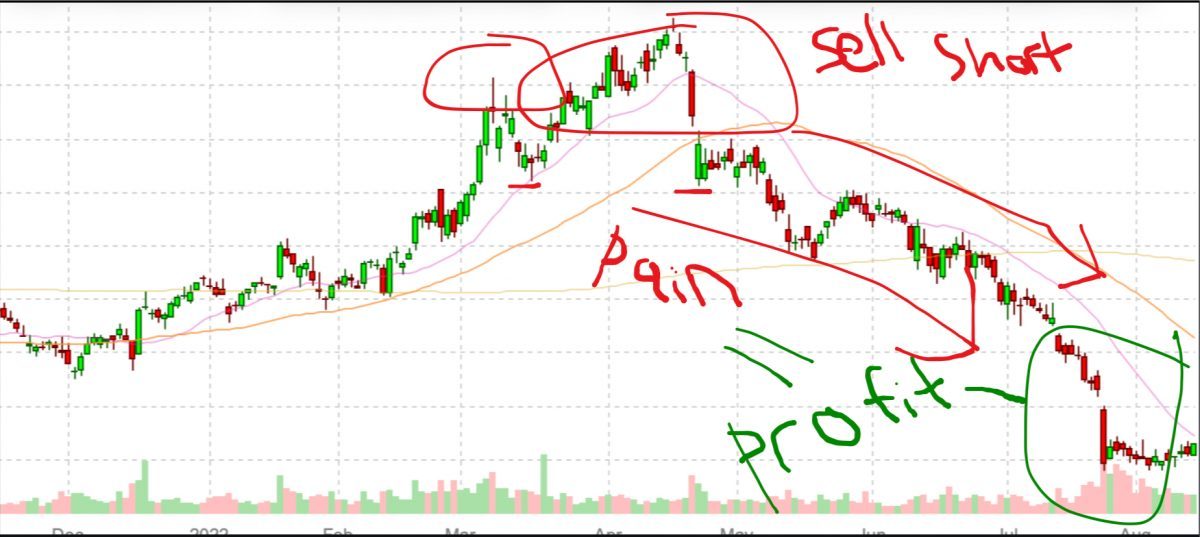Short selling is a strategy that is used by traders to profit from a decline in the price of a security. When short selling, the investor borrows shares of a stock from someone else (could be an individual or a brokerage firm), sells them on the open market, and hopes to buy them back at a lower price to return them to the original lender, thus profiting from the difference.
Example of Short Selling
Let’s say you identify XYZ Company as overvalued and expect the stock price to decline. The current market price of XYZ Company is $50 per share. You decide to short sell 100 shares of XYZ Company.
To do this, you borrow 100 shares of XYZ Company from your broker and sell them on the market at the current price of $50 per share, which gives you $5,000 in cash. You now owe 100 shares of XYZ Company to your broker, which you plan to buy back later at a lower price.
A few days later, the price of XYZ Company drops to $40 per share. You decide to buy back 100 shares of XYZ Company at the current price of $40 per share, which costs you $4,000. You then return the 100 shares to your broker, and you’ve made a profit of $1,000 ($5,000 from selling the shares – $4,000 to buy them back) from short selling XYZ Company.
However, it’s important to note that if the price of XYZ Company had risen instead of fallen, you would have incurred a loss. As discussed below, short selling involves significant risk, and it’s crucial to have a thorough understanding of the market and the specific stock before making any trades.
Risks of Short Selling
- Unlimited Losses: When you buy a stock, the most you can lose is the amount you invested. However, when you short a stock, there is no limit to how much you can lose. If the stock price goes up instead of down, you may have to buy back the shares at a higher price than you sold them for, resulting in a loss that can be greater than your initial investment.
- Short Squeezes: A short squeeze occurs when a large number of investors have shorted a stock, and the stock price unexpectedly rises. Short sellers may be forced to buy back the shares at a higher price to limit their losses, causing the stock price to rise further, creating a feedback loop that can result in substantial losses for short sellers.
- Margin Calls: When you short a stock, you must borrow the shares from a broker, and this requires a margin account. If the value of the borrowed shares increases, your broker may require you to deposit additional funds into your account to cover the increased margin. If you can’t deposit the additional funds, your broker may liquidate your position, resulting in a loss.
- Timing Risk: Short selling requires a good sense of timing. If you short a stock too early or too late, you may miss out on profits or incur significant losses.
- Limited Upside Potential: Unlike owning a stock, short selling has a limited upside potential. The most you can earn from short selling a stock is the difference between the sale price and the buyback price, minus any fees and commissions.
It is important to understand these risks and weigh them against potential profits before engaging in short selling.
Here are 8 things you may want to consider if you are considering short selling stocks:
- Identify stocks that are overvalued or have negative news or rumors surrounding them.
- Research the stock and its industry to gain a better understanding of why the stock may be overvalued or facing negative news.
- Find a broker that allows short selling and open a margin account.
- Borrow shares of the stock you want to short sell from your broker.
- Sell the borrowed shares at the current market price.
- Monitor the stock and its industry news closely to determine when to buy back the shares at a lower price.
- Buy back the shares at a lower price and return them to the original lender.
- Profit from the difference between the price you sold the shares and the price you bought them back for.
Summary
It is important to note that short selling is a risky strategy that can result in significant losses if the stock price does not decline as expected. As such, it is important to have a solid understanding of the stock and its industry before executing a short sale. Additionally, you should always consider your risk tolerance and consult with a Financial Advisor or other Financial professional if you feel it is necessary before engaging in short selling.




